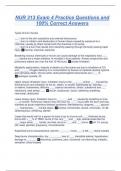Exam (elaborations)
NUR 313 Exam 4 Practice Questions and 100% Correct Answers
- Course
- Institution
Types of burn injuries ___ : burn to the skin caused by any external heat source ___ : burn is irritation and destruction of human tissue caused by exposure to a chemical, usually by direct contact with the chemical or its fumes. ___ : burn is a burn that results from electricity passing through t...
[Show more]



